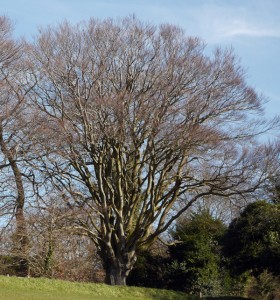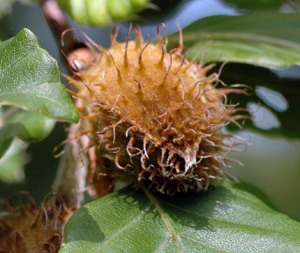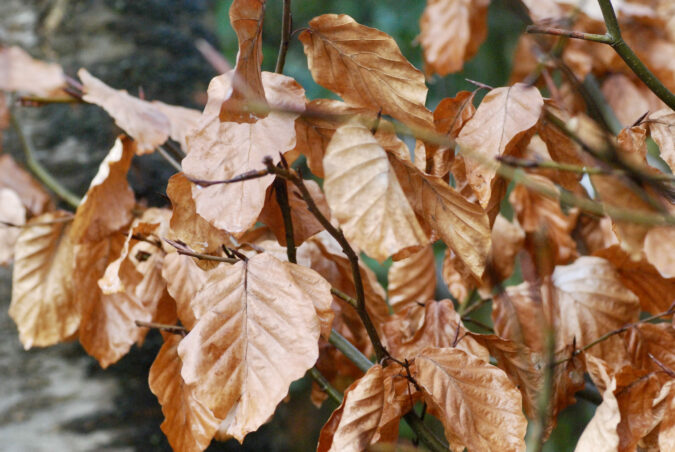Trouble ahead for beech ?

In the southern parts of Britain, beech is a dominant woodland/forest tree, further north, oak is prominent. Beech trees are often large with smooth, silvery grey bark. They can grow to a height of 150 feet, with a stout trunk (perhaps 10 feet in diameter) and an impressive canopy. The leaves, certainly on younger trees, may persist throughout winter in a brown and withered state — a phenomenon known as marcescence. The root system of the beech is shallow but extensive. The large roots spread out in all directions, and establish mycorrhizal connections, often with fungi such as Russula and Laccaria. The mycorrhizae help the trees by supplying mineral nutrients (like phosphate) and water. In return, the trees provide various organic nutrients to the fungus. Despite these associations, beech trees are susceptible to drought. After the drought of the summer of 1976, many beech trees died.
It is not surprising that people are concerned about the ‘health’ of beech trees in light of climate change — higher temperatures, extreme weather, specifically periods of drought. It was thought that climate change would reduce growth of trees like beech through the increasing frequency and intensity of summer droughts. Recently, a study conducted by researchers at the University of Liverpool looked at tree growth data (annual growth ring and masting data) accumulated over more than forty years and found that growth was indeed reduced (by some 28%).
 However, the reason was that the trees were investing more energy into reproduction than into growth. Beech trees are known for their mast years - see previous blog on masting. In a mast year, a tree will produce enormous quantities of seeds (beech nuts✝︎). However, it seems that the changing climate is causing a ‘breakdown’ in the masting process, and whilst the trees now reproduce more more frequently. Total seed production and seed viability is reduced. It may be that the diminished reproductive capacity of beech trees as a result of climate change will affect their ability to regenerate woodlands and forests in the UK and indeed across Europe in the coming years.
However, the reason was that the trees were investing more energy into reproduction than into growth. Beech trees are known for their mast years - see previous blog on masting. In a mast year, a tree will produce enormous quantities of seeds (beech nuts✝︎). However, it seems that the changing climate is causing a ‘breakdown’ in the masting process, and whilst the trees now reproduce more more frequently. Total seed production and seed viability is reduced. It may be that the diminished reproductive capacity of beech trees as a result of climate change will affect their ability to regenerate woodlands and forests in the UK and indeed across Europe in the coming years.

Marcescence
✝︎ Masting means that so many seeds that even the most voracious squirrels cannot consume all of them
* After the summer of 1976, drought damaged trees were still dying some 15 years later.
Comments are closed for this post.
